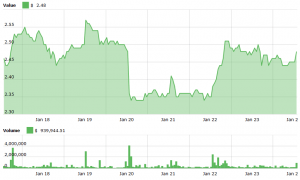EOS Gets New Update for Better Transaction Speed
Block.one, the company behind blockchain platform EOSIO, has announced that they’re releasing latest update to the code, which is said to allow for much greater speeds across the network than previously seen. According to the company, EOSIO 1.6.0 has reached up to 35% better transaction processing speed in internal testing.

EOSIO, a platform for the execution of smart contracts and the building of decentralized applications (dapps), claims to have current maximum speeds recorded on its blockchain at 3,996 transactions per second. Aside from the higher speed, the update also includes reductions in CPU costs and decreased latency, making for cheaper running of applications as well as increasing their responsiveness.
Block.one CEO Brendan Blumer said for the press release, “Our aim is to drive mass adoption of blockchain. As part of the community that continues to work on the EOSIO software and its corresponding advancements, we hope to play a leading role in the next generation of blockchains through our deep engineering talent and our dedication to a future of global commerce and communications based on blockchain.”
EOS, the EOSIO platform’s native token, is currently ranked 5th by market capitalization on coinmarketcap.com, worth USD 2.48 per coin.

The fight for speed on the blockchain is hardly unique for EOSIO. In fact, most other smart contract platforms, such as NEO, Qtum and others are participating in the race. Also, Ethereum’s upcoming Constantinople upgrade boasts four Ethereum Improvement Proposals (EIPs), three of which target speed, efficiency and scalability.
Meanwhile, QtumX, an enterprise-level blockchain system developed by the Qtum team, has recently announced that according to benchmark testing, they can handle more than 10,000 transactions per second. “[QtumX] aims to realize high TPS (Transactions Per Second) and low confirmation time of the blockchain, to make dapps applicable to more business scenarios. Meanwhile, we intend to minimize storage and network consumption, so as to reduce operating costs,” the team announced this week.




